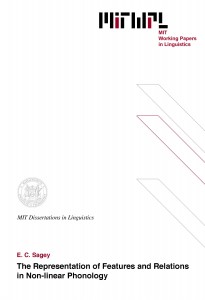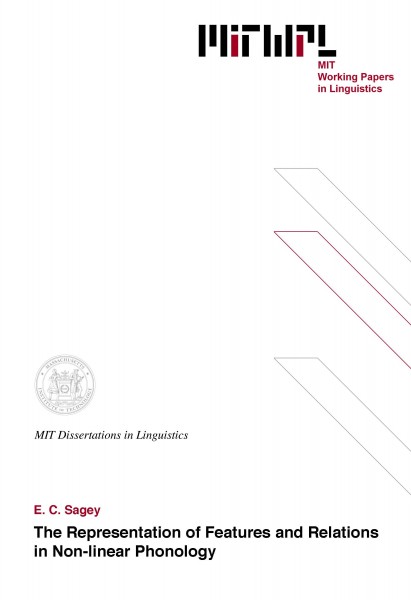The Representation of Features and Relations in Non-linear Phonology
E. C. Sagey, 1986
In this thesis, I propose the following hierarchical representation for the distinctive features of phonology.
![]()
![]()
![]()
![]() root
root
continuant
consonantal
laryngeal
![]()
![]()
![]()
![]()
![]()
![]() supralaryngeal
supralaryngeal
constr. glottis
![]()
![]()
![]()
![]() spread glottis soft palate place
spread glottis soft palate place
stiff v.c.
![]()
![]()
![]()
![]()
![]()
![]() slack v.c. nasal labial coronal dorsal
slack v.c. nasal labial coronal dorsal
round anterior high low back
distributed
This hierarchy is based on phonetics: Features are grouped according to the articulator in the vocal tract that they are executed by. Articulators are grouped according to their acoustic effects on the formant structure.
The hierarchy, which is proposed to be universal, allows a straightforward account of the complex phenomena that surround multiply-articulated segments, such as labiovelars, labiocoronals, coronovelars (e.g. clicks), and labialized, palatalized, or velarized consonants. This type of segment, with unordered or simultaneous multiple articulations, I refer to as a complex segment. The theory of representation I propose makes it possible to represent all the complex segments that occur, and provides an explanation of why those complex segments that occur are possible in a language, as well as of why those that do not occur are impossible. Furthermore, it makes possible an account of the derivation of complex segments, where they are derived, and of their behavior with respect to phonological processes. In addition, the proposed theory of representation is shown to account for unrelated phenomena in languages without complex segments, which provides independent support and shows that the representation is universal, rather than particular to complex segment languages.
In Chapters 1 and 2, I argue for the hierarchical feature groupings shown above. (The root, laryngeal, supralaryngeal, and place constituents were proposed by Mohanan (1983) and Clements (1985).) I demonstrate that the only complex segments that occur are those combining two or more of the hierarchical constituents: labial, coronal, dorsal. I argue, based on timing, syllabification, reduplication, compensatory lengthening, prenasalization, and nasal assimilation, that complex segments occupy single x-slots, and furthermore that the multiple articulations in complex segments must be represented within a single place node. Complex segments are contrasted with contour segments, in that the latter involve sequences of articulations within a single segment " a distinction which determines the different behavior of complex and contour segments with respect to phonological rules. Furthermore, I show that the structure within the place node required by complex segments finds independent support in languages without complex segments. For example, the structure allows us to account for patterns of blocking and transparency in harmony systems. Thus, the structure within the place node is a universal property of the representation of distinctive features, rather than just a peculiarity of complex-segment languages.
In Chapter 3, I propose a mechanism for assigning the degree of closure features [continuant, consonantal] to the articulators that execute them. This representation of degree of closure features is necessary in order to account for the behaviors of complex segments, and furthermore allows degree of closure in complex segments to be represented identiically to that in simple segments. The modifications of the feature representation that are necessary to represent and account for the behavior of complex segments lead to a concise characterization of the possible complex segments in human language.
In Chapter 4, I redefine the distinctive features (i.e. the terminal nodes in the hierarchy) in light of the proposal made in Chapters 1, 2, and 3, and I define the non-terminal nodes in the hierarchy.
Chapter 5 contains a further demonstration of the possibility of explaining phonology in terms of external factors. I demonstrate that the association lines among features and x-slots that connect all the tiers in the hierarchy must represent the relation of overlap in time, and I show that when they are correctly defined as representing overlap, the ill-formedness of crossing association lines follows from the relations represented in a phonological representation, together with knowledge of the world, and need not be stipulated as well-formedness condition in UG.
Finally, in Chapter 6, I discuss two aspects of phonetic representation that are made possible by the view of phonological representations taken in Chapters 1 through 5 " degrees of closure of individual articulators and subsegmental timing.
Thesis supervisor: Morris Halle
Title: Institute Professor
Table of Contents
Chapter 1 Introduction 9
1.1 Non-linear representation 19
1.2 Feature groupings 25
1.2.1 Laryngeal and supralaryngeal nodes 31
1.2.2 Place node 37
1.2.3 Root node 40
1.2.4 Manner features 45
1.3 Contour segments 49
1.4 Overview 52
Appendix Notation 54
Chapter 2 Complex Segments and Place Feature Geometry 56
2.1 Structure within the place node: articulator nodes 57
2.2 Articulatory independence " possible complex segments 63
2.3 Clusters vs. contour or complex segments 69
2.3.1 Syllable structure 69
2.3.2 Compensatory lengthening 73
2.3.3 Urhobo nasal harmony 76
2.3.4 Timing 78
2.3.4.1 Prenasalized stops 80
2.3.4.2 Affricates 81
2.3.4.3 Labiovelars 83
2.3.5 Reduplication and association to the skeleton 85
2.3.6 Lack of gemination 88
2.3.7 Dan (Santa) 90
2.4 Contour vs. complex segments " ordered vs. unordered 92
2.4.1 Contour segments 93
2.4.2 Complex segments 99
2.4.2.1 Nasal assimilation and prenasalization 100
2.4.2.2 Spreading and "metathesis" 105
2.4.2.3 !Xoo clicks 126
2.5 Phonological processes applying to articulator nodes 131
2.5.1 Coronal articulator node 132
2.5.1.1 Sanskrit N-retroflexion 132
2.5.1.2 English coronal assimilation 135
2.5.1.3 Karanga labio-corono-velar simplification 136
2.5.2 Labial articulator node 137
2.5.2.1 Tulu vowel rounding 137
2.5.2.2 Chukchee 139
2.5.2.3 Nootka 141
2.5.2.4 Relation between labial and round 141
2.5.3 Dorsal articulator node 145
2.5.3.1 Fanti 146
2.5.3.2 Vowel harmony 147
2.6 Impossible feature dependencies 148
2.7 Summary 150
Chapter 3 Degree of Closure Features 151
3.1 Place features are independent of degree of closure 151
3.2 Degree of closure in multiply-articulated segments 153
3.2.1 Hottentot 156
3.2.1.1 Influxes 159
3.2.1.2 Effluxes 162
3.2.2 Margi 175
3.2.3 !Xu 191
3.3 Major and minor articulators 199
3.3.1 Nupe 209
3.3.2 Shona 218
3.3.3 Kinyarwanda 227
3.3.4 Fula 240
3.4 Comparison of major/minor distinction with alternatives 247
3.4.1 Separate degree of closure for each articulator 248
3.4.2 Suction/pressure of movement features 252
3.4.2.1 Ejectives and implosives 253
3.4.2.2 Clicks 257
3.5 Further applications of major/minor 260
3.5.1 Ngbaka 260
3.5.2 Margi 266
3.5.3 Palatalization and distribution of velars in Hottentot 267
3.6 Summary 272
Chapter 4 Phonological Features 273
4.1 Class features 273
4.2 Terminal features 277
4.3 Residue 280
Chapter 5 Association Lines 282
5.1 Introduction 282
5.2 Relations and representations 284
5.2.1 Precedence 284
5.2.2 Association lines 285
5.3 Eliminating the well-formedness condition 294
5.4 Comparison with Goldsmith"s formalization 297
5.5 Conclusion 300
Chapter 6 Phonetic Representations 302
6.1 Degree of closure of minor articulators 304
6.2 Subsegmental timing 310

